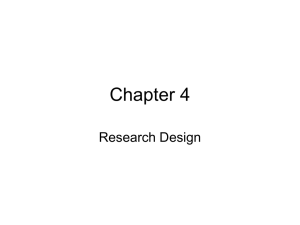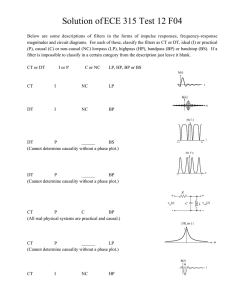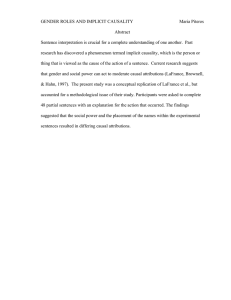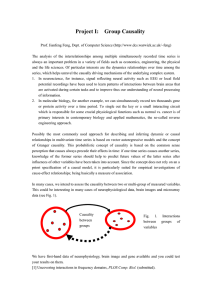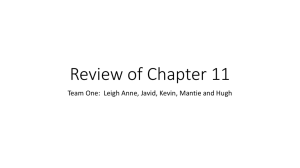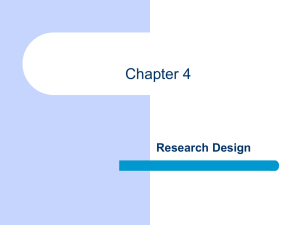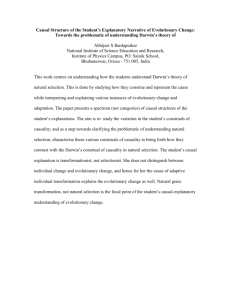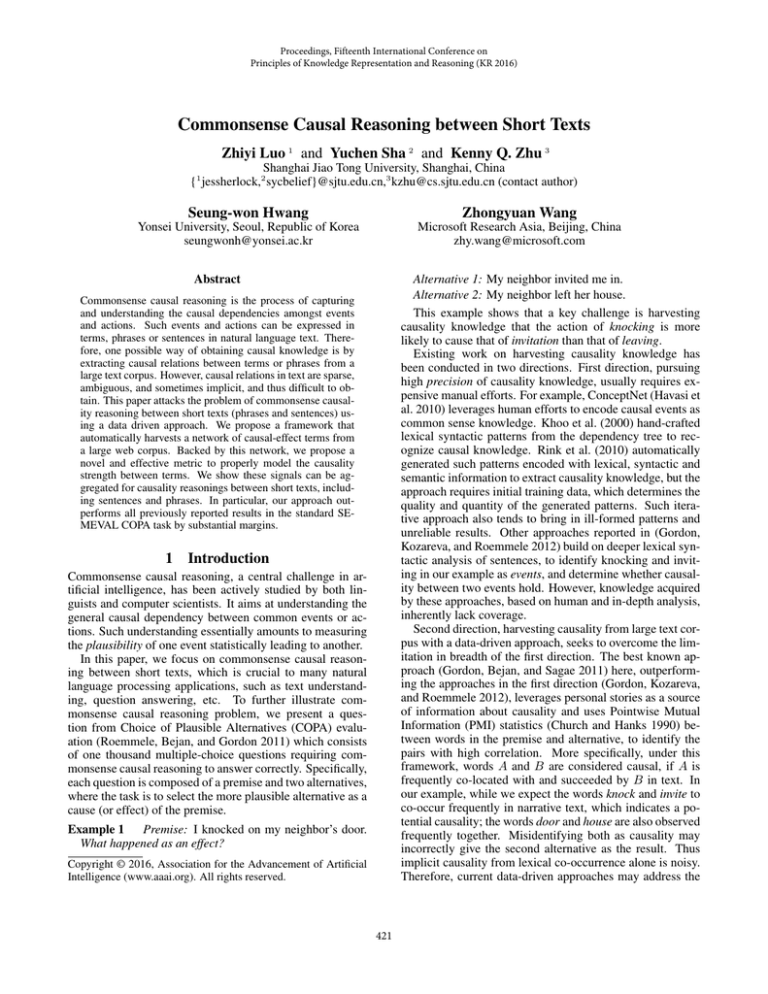
Proceedings, Fifteenth International Conference on
Principles of Knowledge Representation and Reasoning (KR 2016)
Commonsense Causal Reasoning between Short Texts
Zhiyi Luo 1 and Yuchen Sha 2 and Kenny Q. Zhu 3
Shanghai Jiao Tong University, Shanghai, China
{1 jessherlock,2 sycbelief}@sjtu.edu.cn,3 kzhu@cs.sjtu.edu.cn (contact author)
Seung-won Hwang
Zhongyuan Wang
Yonsei University, Seoul, Republic of Korea
seungwonh@yonsei.ac.kr
Microsoft Research Asia, Beijing, China
zhy.wang@microsoft.com
Alternative 1: My neighbor invited me in.
Alternative 2: My neighbor left her house.
This example shows that a key challenge is harvesting
causality knowledge that the action of knocking is more
likely to cause that of invitation than that of leaving.
Existing work on harvesting causality knowledge has
been conducted in two directions. First direction, pursuing
high precision of causality knowledge, usually requires expensive manual efforts. For example, ConceptNet (Havasi et
al. 2010) leverages human efforts to encode causal events as
common sense knowledge. Khoo et al. (2000) hand-crafted
lexical syntactic patterns from the dependency tree to recognize causal knowledge. Rink et al. (2010) automatically
generated such patterns encoded with lexical, syntactic and
semantic information to extract causality knowledge, but the
approach requires initial training data, which determines the
quality and quantity of the generated patterns. Such iterative approach also tends to bring in ill-formed patterns and
unreliable results. Other approaches reported in (Gordon,
Kozareva, and Roemmele 2012) build on deeper lexical syntactic analysis of sentences, to identify knocking and inviting in our example as events, and determine whether causality between two events hold. However, knowledge acquired
by these approaches, based on human and in-depth analysis,
inherently lack coverage.
Second direction, harvesting causality from large text corpus with a data-driven approach, seeks to overcome the limitation in breadth of the first direction. The best known approach (Gordon, Bejan, and Sagae 2011) here, outperforming the approaches in the first direction (Gordon, Kozareva,
and Roemmele 2012), leverages personal stories as a source
of information about causality and uses Pointwise Mutual
Information (PMI) statistics (Church and Hanks 1990) between words in the premise and alternative, to identify the
pairs with high correlation. More specifically, under this
framework, words A and B are considered causal, if A is
frequently co-located with and succeeded by B in text. In
our example, while we expect the words knock and invite to
co-occur frequently in narrative text, which indicates a potential causality; the words door and house are also observed
frequently together. Misidentifying both as causality may
incorrectly give the second alternative as the result. Thus
implicit causality from lexical co-occurrence alone is noisy.
Therefore, current data-driven approaches may address the
Abstract
Commonsense causal reasoning is the process of capturing
and understanding the causal dependencies amongst events
and actions. Such events and actions can be expressed in
terms, phrases or sentences in natural language text. Therefore, one possible way of obtaining causal knowledge is by
extracting causal relations between terms or phrases from a
large text corpus. However, causal relations in text are sparse,
ambiguous, and sometimes implicit, and thus difficult to obtain. This paper attacks the problem of commonsense causality reasoning between short texts (phrases and sentences) using a data driven approach. We propose a framework that
automatically harvests a network of causal-effect terms from
a large web corpus. Backed by this network, we propose a
novel and effective metric to properly model the causality
strength between terms. We show these signals can be aggregated for causality reasonings between short texts, including sentences and phrases. In particular, our approach outperforms all previously reported results in the standard SEMEVAL COPA task by substantial margins.
1
Introduction
Commonsense causal reasoning, a central challenge in artificial intelligence, has been actively studied by both linguists and computer scientists. It aims at understanding the
general causal dependency between common events or actions. Such understanding essentially amounts to measuring
the plausibility of one event statistically leading to another.
In this paper, we focus on commonsense causal reasoning between short texts, which is crucial to many natural
language processing applications, such as text understanding, question answering, etc. To further illustrate commonsense causal reasoning problem, we present a question from Choice of Plausible Alternatives (COPA) evaluation (Roemmele, Bejan, and Gordon 2011) which consists
of one thousand multiple-choice questions requiring commonsense causal reasoning to answer correctly. Specifically,
each question is composed of a premise and two alternatives,
where the task is to select the more plausible alternative as a
cause (or effect) of the premise.
Example 1 Premise: I knocked on my neighbor’s door.
What happened as an effect?
Copyright © 2016, Association for the Advancement of Artificial
Intelligence (www.aaai.org). All rights reserved.
421
(1) The [storm]CAUSE [caused]PATTERN a tremendous amount
of [damage]EFFECT on the landing beaches.
coverage limitation of causality acquisition, but suffer from
low precision in return.
In contrast, our goal is to pursue both coverage and precision in modeling causality. Combining in-depth lexical syntactic analysis with personal stories is not an option because
given the limited availability of such data, the amount of extractable precise causal knowledge would be much smaller.
To pursue coverage, we propose a data-driven approach of
harvesting a comprehensive term-based causality network
from a large web corpus. Such network would encode tens
of thousands of unique terms, and tens of millions of causality evidences, much larger scale than other existing causal
knowledge bases (more comparisons in Section 3.1).
To pursue precision, we leverage explicit causal indicators
(e.g., cause, because), to prune substantial non-causal cooccurrences and introduce separate cause and effect roles to
every term in our causality knowledge.
With the differentiated cause and effect roles of causalities encoded in text, our causality network carries more reasonable and directional causal co-occurrences, e.g., from
the corpus, knock causes invite m times, while invite
causes knock n times. Furthermore, we distinguish sufficiency causality (i.e., A is the sufficient condition to cause
B) from necessity causality (i.e., A is the necessary cause of
B). These refined representations of terms and their causal
relations give rise to new ways of computing causal strength
between terms and between texts, thus yields better results
in commonsense causal reasoning.
In sum, this paper makes the following contributions:
• We harvest a term-based causality co-occurrences network from large web text by leveraging causal cues (see
Section 2.1);
• We develop a new statistical metric that captures causal
strength between any two pieces of short texts (see Section 2.2 and Section 2.3);
• Our proposed framework achieves state-of-the-art accuracy of 70.2% on the difficult COPA task, outperforming
all existing methods by subtantial margins. Further evaluation on causality detection between phrases also demonstrate the advantage of the proposed framework (see Section 3).
2
(2) The team prepared GIS precipitation and contour maps
of the area identifying the [flooding]EFFECT and landslides
[caused by]PATTERN the [rainfall]CAUSE .
(3) However Susanoo was in [sorrow]EFFECT after the
[loss]CAUSE of his mother and he was raging in his kingdom.
In sentence (1), ‘storm’ is the cause of ‘damage’, and ‘damage’ is the effect of ‘storm’. We exploit causal cues (causal
patterns) shown in Table 1, to identify cause and effect roles
for our causality knowledge. For example, “A cause B”
is an intra-sentence causal cue where A is a text span that
represents the cause and B is a span that represents the effect. We set a maximum length L of text span A and B
to prevent extracting noisy pairs too far away from causal
cues.1 The text span can be a term, a phrase or a sentence.
There are also discourse cues such as “If A then B”. Table 1 shows all 53 intra-sentence and discourse causal cues
used in this work. We extract all such patterns from a large
web corpus, and after lemmatization, pair each term i in
A as cause role, denoting as ic , with each term j in B as
effect role, denoting as je , to form a list of causal pairs
(ic , je ) as causal evidences. Therefore, from sentence (1),
we can harvest (stormc , tremendouse ), (stormc , amounte ),
(stormc , damagee ), (stormc , landinge ), and (stormc , beache )
as causal evidences. In this process, we remove the stop
words and only pairs involving nouns, verbs, adjectives and
adverbs from WordNet are retained.
Our extracted causal pairs form a directed network of
causal relations. Each node in this network is a lemmatized
term, while a directed edge between two terms indicates a
causal relation. A fragment of the causal network with three
terms in the network is shown in Figure 1. Each edge is annotated with the causality co-occurrences, i.e., the number
of times this causal relation was observed in the corpus.
We choose to extract term pairs in a rather simplistic
way, without deeper syntactic analysis, because i) we opt
for breadth in the causal knowledge hence the input corpus
is extremely large (around 10TB), and consequently deep
parsing of the text becomes prohibitive; and ii) the sheer
quantity of the term pairs thus obtained provides excellent
statistics for us to distinguish true causal relations against
false ones.
Approach
To reason about causality between short texts, our framework includes i) a network of causal relation weighted with
causality co-occurrences between terms that is extracted
from a large web corpus; ii) a novel metric to compute causal
strength between any two terms based on this network; iii)
a simple algorithm for aggregating the causality between
terms to compute the overall score for causality reasoning
between short texts, including phrases and sentences. Next,
we describe these components.
2.1
rain
153
123
40
umbrella
399
4
wet
2
Causality Network
s Causality is expressed by natural language texts and
can be identified by linguistic patterns known as causal
cues (Chang and Choi 2004). Consider the following sentences:
Figure 1: A fragment of causal network
1
422
In our experiments, we empirically set L to be 10.
Table 1: 53 Causal cues. A is a cause span, and B is an effect span. DET stands for a/an/the/one. BE stands for is/are/was/were.
A lead to B
A leading to B
A given rise to B
A inducing B
A cause B
A caused B
A brought on B
B result from A
B resulted from A
DET effect of A BE B
2.2
intra-sentence
A leads to B
A led to B
A give rise to B
A gave rise to B
A giving rise to B
A induce B
A induces B
A induced B
A causing B
A causes B
B caused by A
A bring on B
A bringing on B
A brings on B
B resulting from A B results from A
the reason(s) for/of B BE A
A BE DET reason(s) of/for B
inter-sentence
If A, B
If A, then B
B because of A
B because A
A, therefore B
A, thus B
Inasmuch as A, B B, inasmuch as A
Due to A, B
B due to A
B as a result of A
B owing to A
Owing to A, B
A and hence B
A, consequently B
A, hence B
A, for this reason alone , B
B, because A
Because A, B
B, A as a consequence
In consequence of A, B
B in consequence of A
As a consequence of A, B
B as a consequence of A
A and consequently B
the larger the p(ic |je ) should be; the stronger the sufficiency
causality is, the larger the p(je |ic ) should be. We are able
to compute such conditional probability because we distinguish the terms by cause or effect roles. However, the frequent terms are more likely to be extracted as either causes
or effects, which makes the conditional probability metric
bias toward highly frequent terms. Therefore, we adopt a
more general form (with a penalty factor) to model the necessity causal strength and sufficiency causal strength encoded by (ic , je ), as shown in Equation (1) and Equation (2)
respectively.
Causal Strength Computation
Text corpus can explicitly as well as implicitly encode
causality. Explicit causality is represented in text with causal
patterns or indicators (e.g., cause, because). Implicit causality is naturally encoded in discourse without indicators, e.g.,
A appears before B in discourse implies that A is a cause of
B, which is more complex and difficult to recognize. For example, sentence (1) and (2) explicitly encode causalities using causal patterns, while sentence (3) encodes the implicit
causality (lossc , sorrowe ).
Gordon et al. (2011) collected implicit causality from
personal story corpus using asymmetric PMI described by
Church(1990), to achieve the previous best known result on
COPA task. The intuition is that narrations typically describe a series of events ordered by time. The text that appears earlier tends to be the antecedent while the text that
comes later tends to be the consequent. Therefore, asymmetric PMI statistics can be used to capture the implicit
causalities encoded in narrative texts such as personal stories. However, while personal stories might be a good source
of implicit causality, they are hard to come by and limited in
scale. In contrast, using a larger general web corpus improves coverage but trading accuracy, as web sentences may
not follow a narrative pattern.
To leverage the scale and richness of the web text,
we model causality more properly by replacing lexical
co-occurrences with causality co-occurrences extracted by
causal cues. Lexical co-occurrences are weak and implicit causal evidences, while causality co-occurrences are
stronger and more explicit causal evidences due to the use
of causal cues. Causal cues also help to identify precise
cause/effect roles in strong causal evidences. Then we
propose a new metric to measure causal strength between
two terms with the insight that the connotation of causality integrates necessity causality with sufficiency causality.
Considering a causal pair (ic , je ), necessity causality encoded by (ic , je ) represents that the cause i must be present
in order for the effect j to take place, while sufficiency
causality encoded by (ic , je ) represents that cause i is all
it takes bring about the effect j. For example, the causality
(rainfallc , floodinge ) in sentence (2) encodes more necessity
causality, since in most situations the effect flooding cannot
happen if rainfall did not happen as its cause. Similarly,
(stormc , damagee ) in sentence (1) encodes more sufficiency
causality. Intuitively, the stronger the necessity causality is,
p(ic |je )
pα (ic )
p(ic , je )
= α
p (ic )p(je )
CSnec (ic , je ) =
p(je |ic )
pα (je )
p(ic , je )
=
,
p(ic )pα (je )
(1)
CSsuf (ic , je ) =
(2)
where α is a constant penalty exponent value. We follow
Wettler (1993) to set α to be 0.66, penalizing high-frequency
response terms. p(ic ), p(je ) and p(ic , je ) are computed as
follows:
f (ic , we )
p(ic ) = w∈W
(3)
M
f (wc , je )
(4)
p(je ) = w∈W
M
f (ic , je )
p(ic , je ) =
(5)
N
Here, f (ic , je ) is frequency of observing the causal pair
(ic , je ) from the corpus; M is the total number of evidences,
computed as:
f (uc , ve ),
u∈W v∈W
and N is the size of the corpus; W is the set of all terms in
the causality network.
To show the effectiveness of CSnec and CSsuf , we
compute the necessity causality and suffiency causality for
423
in contributing causal strength, either in CSnec or CSsuf .
Each term in the cause role may cause a number of terms in
the effect role and each term in the effect role maybe caused
by a number of terms in the cause role. Based on this one-tomany relation, we normalize total causality score by |T1 | +
|T2 |, which is the total number of agents, and not |T1 | × |T2 |
presented in previous papers.
One alternative way of constructing the causality network
is to extract causal pairs between phrases instead of terms,
since there exists complex events (e.g., “catch cold”) that
cannot be expressed by a single word. However, we empirically discovered that such network is less effective since the
frequencies tend to be diluted, which we report in Section 3,
and even though “catch cold” is not in our network, we could
better capture phrase causality based on the combined contribution of individual words “catch” and “cold.”
causal pairs annotated in SemEval-2010 task 8.2 We show
the top necessary causal pairs and sufficient causal pairs
CS
CSnec
ranked by CS
and CSsuf
respectively as shown in Table
nec
suf
2.
Table 2: Top necessary and sufficient causal pairs
Necessary Causal Pairs
(manc , kidnappinge )
(manc , jollinesse )
(windc , corkscrewe )
(rainfallc , floodinge )
(accidentc , snarle )
(erosionc , rille )
(crashc , gashe )
(virusc , tonsillitise )
(fightc , carnagee )
(earthquakec , avalanchee )
Sufficient Causal Pairs
(neuromac , paine )
(eyestrainc , headachee )
(flashlightc , lighte )
(typhoonc , damagee )
(sunrisec , lighte )
(claustrophobiac , panice )
(quakec , damagee )
(bacteriac , meningitise )
(quakec , losse )
(overproductionc , growthe )
3
In this section, we first give some statistics of our corpus
and the extracted causality network, and evaluate the quantity and quality of the cue patterns used in the extraction. We
then compared our results on the main COPA task against a
number of existing works using various other data sources
and knowledge bases. Next, we evaluate causality reasoning on two additional tasks using the data from ConceptNet
4 to further showcase the power of our framework. Finally,
we demonstrate our network’s ability to identify causal directions using annotated corpus of SemEval-2010 task 8,
despite being agnostic about the context of the input word
pairs. We release the evaluation data used in these experiments at http://adapt.seiee.sjtu.edu.cn/causal/.
Our new causal strength encoded by pair (ic , je ) combines CSnec (ic , je ) with CSsuf (ic , je ), and is defined in
Equation (6).
CS(ic , je ) = CSnec (ic , je )λ CSsuf (ic , je )1−λ
(6)
The above metric models both the necessity and sufficiency
components of causality and captures the intuition that the
causal strength should be stronger when both necessity and
sufficiency causality are strong. Here, λ is a parameter,
weighing the necessity and sufficiency causality knowledge
that is extracted from text corpus. A desirable λ depends on
the characteristics of knowledge source and extraction methods, as we show in Section 3.
We compute the causal strength between every pair of
terms in the causality network according to Equation (6).
Where an edge is missing in the network, we assign a causal
strength of zero.
2.3
3.1
Data Set and Extraction of Causality Network
We extracted our term causality network, which we call
“CausalNet” for convenience in this section, from a large
web text corpus (a snapshot of Bing, approximately 10TB),
which contains about 1.6 billion web pages. We extract
62,675,002 distinct causality evidences (e.g., causal pairs
or edges in CausalNet) from this corpus. The average frequency of these evidences is 10.54. The number of unique
lemmatized terms (nodes) in these evidences is 64,436, covering 41.49% (64,436/155,287) of the words in WordNet.
As a comparison, we separately extracted an “eventbased” CausalNet using dependency relations (Chen and
Manning 2014) such as advmod and dobj. Only bigramphrases that match these relations and appear more than
20,000 times in the corpus are considered events; otherwise
they are split into words and paired up as before. The average frequency on the edges of this event-based CausalNet is
1.59, much smaller than the orginal CausalNet, which would
make our metric inaccurate due to its sparsity. Therefore,
subquent experiments are done on the term-based CausalNet.
The 53 causal cues we used can be grouped into 17 sets,
each containing cues of the same meaning or lemma form
but with different tenses. Causal evidences distribution over
these pattern sets is shown in Figure 2. The blue bars (left)
are the number of distinct pairs and the orange ones (right)
Commonsense Causal Reasoning
To compute whether alternative a1 or a2 is more plausible
with respect to the premise p, we need to compare the overall
causality strength CST (p, a1 ) and CST (p, a2 ), assuming p
is asking for an effect. Here, we compute the causal strength
from text T1 to text T2 as:
1
CST (T1 , T2 ) =
CS(i, j) (7)
|T1 | + |T2 |
i∈T1 j∈T2
We argue that such simple approach to aggregate causal
strength between terms can effectively model causality between short texts. The intuition is that each pair of terms
drawn from the two texts contribute to the total causal
strength between the two texts. Because CS(ic , je ) can be
closely related to a probability (with penalty factors), summing up the causal strength between all pairs is analogous
to computing a pairwise disjunctive probablity.
Furthermore, in our causality model, each term, whether
in the cause role or the effect role, acts as an active agent
2
Experimental Results
We further discuss this corpus in Section 3
424
ϭ͘нϬϯ
ϭϬϬй
ϴϬй
ϭ͘нϬϮ
ϲϬй
ϭ͘нϬϭ
ϰϬй
ϭ͘нϬϬ
ϮϬй
Ϭй
ϭ͘ͲϬϭ
ĚŝƐƚŝŶĐƚƉĂŝƌƐ
ƚŽƚĂůƉĂŝƌƐ
ƌĂƚŝŽ
Figure 2: Number of (distinct) pairs extracted by cues
show the total number of pairs. Inter-sentence cues like “if”
and “because” harvested the largest number of pairs. But
more specialized patterns such as “reason” and “inasmuch”
find more diverse pairs, since the number of distinct pairs
is relatively large compared to the total pairs extracted. We
show such diversity by the ratio between number of distinct
pairs and number of total pairs and this ratio is marked by
gray line in Figure 2.
To evaluate the quality of the causal cues, we make use of
the manually labeled causal events in ConceptNet (Liu and
Singh 2004) as ground truth. ConceptNet 4 contains 74,336
unlemmatized English words, forming 375,135 unique concepts, which are connected by 610,397 relation edges. Only
some of these relations encode causal knowledge, such as
“Causes”, “CausesDesire” and “HasPrerequisite”. The total
number of such causal relations is 52,778. Each causal relation also associates with a vote from volunteers. Those pairs
associated with positive votes are annotated as causal pairs
(e.g. (listen to musicc , relaxe ) ), while associated with negative votes are annotated as false causal pairs (e.g. (listen to
musicc , soda cane ) ).
Since the pairs from ConceptNet contain phrases and not
just words, we consider a pair (x, y) (x and y are text spans)
to be covered by a causal cue, if at least one word u in x and
another word v in y form the causal pair (uc , ve ) which can
be extracted word by that cue from the web corpus. Figure
3 shows that in general, our cues can effectively distinguish
between positive and negative causal pairs.
3.2
premise and alternative and choose the alternative with a
higher PMI.
We trained our CSλ metric on the development set of
COPA for different data sources (i.e., web corpus and
CausalNet). That means we compute CS based on lexico co-occurrences from web corpus, while computing CS
based on causality co-occurrences from CausalNet. During
the training period, CSλ=0.9 and CSλ=1.0 achieve the same
best results using CausalNet while CSλ=0.5 performs the
best using the web corpus on the development set. Then
we show the performance of these trained CS metrics on
test split of COPA. Table 3 shows that CSλ=0.5 on web data
(64.8%) outperforms PMI with any window sizes. Table 3
also compares CSλ=1.0 on CausalNet with several other approaches. PMI Gutenberg (Roemmele, Bejan, and Gordon
2011) uses PMI statistic calculated from Project Gutenberg
(16GB of English-language text). UTDHLT (Goodwin et al.
2012) is the result of SemEval-2012 Task 7 systems. They
propose two approaches. The first one uses PMI over bigrams from LDC Gigaword corpus (8.4 million documents)
as a feature. The second one treats the task as a classification problem and combines the features used in the first
approach with some additional features to train an SVM
model. The ConceptNet approach was our own baseline
to illustrate the power of human curated knowledge. Here
we fuzzy match the events or concepts from ConceptNet in
COPA sentences, and then compute the causal strength between two COPA sentences by the scores (e.g.votes) associated with causal relations in ConceptNet. 23 out of 500
questions on COPA test split are matched by ConceptNet,
and 18 of them are correctly answered, by computing the
causality strength between two COPA sentences from the
votes associate with causal relations in ConceptNet. We just
randomly select an answer for mismatched questions. The
last PMI method (Gordon, Bejan, and Sagae 2011), which
was also the state-of-the-art previously (65.4%), uses a large
corpus of personal stories (37GB of text) with a window of
25. All competing systems were assessed based on their accuracy on the 500 questions in the COPA test split (Gordon,
Kozareva, and Roemmele 2012). Results show that our new
metric CSλ=0.9/1.0 , when used together with the automat-
End-to-end Evaluation on COPA
COPA task consists of 1000 commonsense causal reasoning questions, divided into development question set and test
question set of 500 each. The incorrect alternative was purposely set semantically close to the premise, which makes
this task more difficult for purely associative methods. In
this experiment, our parameter λ was trained on the development set. All the reported results are on test set.
To show the usefulness of our causal strength metric, denoted as CS, we compare the end-to-end results on COPA
with the best known PMI statistics on the web corpus. To
solve COPA question with PMI, we pair the terms from
425
ϭϬϬй
ϴϬй
ϲϬй
ϰϬй
ϮϬй
Ϭй
ƉĞƌĐĞŶƚĂŐĞŽĨƉŽƐŝƚŝǀĞƉĂŝƌƐĐŽǀĞƌĞĚ
ƉĞƌĐĞŶƚĂŐĞŽĨŶĞŐĂƚŝǀĞƉĂŝƌƐĐŽǀĞƌĞĚ
Figure 3: Number of causal vs. non-causal pairs from ConceptNet covered by cues
ϳϮ
ically harvested CausalNet achieves significantly better accuracy on the COPA task.
ĐĐƵƌĂĐLJ;йͿ
Table 3: COPA results comparison
Data Source
Web corpus
Gutenberg
LDC Gigaword
ConceptNet
1-Million Stories
10-Million Stories
CausaNet
Methods
PMI (W=5)
PMI (W=10)
PMI (W=15)
PMI (W=25)
CSλ=0.5
PMI (W=5)
PMI (W=25)
UTDHLT Bigram PMI
UTDHLT SVM
Fuzzy match
PMI (W=25)
PMI (W=25)
CSλ=1.0
ϲϵ͘ϰ
ϳϬ
ϲϴ
ϲϱ
ϲϰ
ϲϰ͘ϲ
ϲϴ͘ϴ
ϲϴ͘ϴ
ϮϬй
ϳϬ͘Ϯ
ϳϬ͘Ϯ
ϲϲ͘ϰ
^
ϲϮ
ϲϬ
Accuracy(%)
61.6%
61.0%
60.4%
61.2%
64.8%
58.8%
58.6%
61.8%
63.4%
51.3%
65.2%
65.4%
70.2 %
ϲϲ͘ϲ
ϲϲ
ϲϵ
ϰϬй
ϲϬй
ʄсϬ͘ϵ
ϴϬй
^
ʄсϭ͘Ϭ
ϭϬϬй
WĞƌĐĞŶƚĂŐĞŽĨǁĞďĐŽƌƉƵƐ
Figure 4: COPA evaluation on different scales of CausalNet
When computing causal strength using implicit causality
evidences, the web data is largely unbiased and hence the
causality evidences are observed with roughly equal sufficiency and necessity causality. Therefore λ = 0.5 gives the
best result. However, when computing CS from CausalNet
which is biased by the explicit causality patterns, a different λ is expected. Because people rarely state “A causes B”
in text explicitly, when A apparently implies B, sufficiency
causality is seldom observed from CausalNet, hence a larger
λ value gives better results.
To further illustrate the effect of web data size on commonsense causal reasoning, we randomly sample 20%, 40%,
60% and 80% of our web corpus and thus construct various
CausalNets of increasing sizes. The accuracies of COPA
evaluation using these knowledge bases with CSλ=0.9 and
CSλ=1.0 are shown in Figure 4. One can observe a general
positive correlation between the size of the data and the ability to reason about commonsense causality. Even at 100%,
that is the whole of the web corpus available to us, this trend
shows no signs of diminishing, which means, given more
data, the results may be even better. The curves in Figure 4
also shows a small bump at 60% of data. This is probably
due to the randomness in the data distribution (e.g., the inclusion of certain type of web pages) and doesn’t change the
overall scalability of our framework.
To understand the effect of λ in our metric on causal
reasoning, we conduct more experiments on COPA using
different values of λ, and on both web corpus and CausalNet. As baselines, we also include the results using conditional probabilities in dual directions, p(ic |je ) and p(je |ic ).
The results are shown in Table 4. Generally, conditional
probability underperforms in this task for both data sources.
Table 4: COPA results for different CS variants
Data Source
Web corpus
CausalNet
426
Methods
p(je |ic )
p(ic |je )
CSλ=0.5
CSλ=0.7
CSλ=0.9
CSλ=1.0
p(je |ic )
p(ic |je )
CSλ=0.5
CSλ=0.7
CSλ=0.9
CSλ=1.0
Accuracy(%)
58.2%
62.8%
64.8%
63.4%
63.0%
63.0%
56.2%
60.2%
68.8%
69.4%
70.2%
70.2%
3.3
Causality Detection
Sentence:
I too, get a e1 headache/e1 from e2 wine/e2, and
was always told that it was the sulfites.
Relation:
Cause-Effect(e2,e1)
In the above example, e1 represents the term “headache”,
and e2 represents “wine”. The relation Cause-Effect(e2,e1)
indicates that the causality encoded in this sentence is
(winec , headachee ), but not (headachec , winee ). We can obtain this useful insight by the prior knowledge from CausalNet. We simply compare the causal strength of (ic , je ) with
that of (jc , ie ) provided by CausalNet. If CS(ic , je ) >
CS(jc , ie )(λ = 0.5), we conclude that the causality is encoded by (ic , je ), otherwise the causality is encoded by
(jc , ie ).
The agreement between CausalNet and annotated ground
truth in SemEval-2010 Task 8 is 80.1%, i.e., 716 out of
894 pairs from SemEval find a matching pair in the same
causal direction from CausalNet. Table 6 shows 20 random
samples of annotated causal pairs from SemEval-2010 Task
8 corpus. 10 of those are matched by CausalNet and the
rest are not. Three human judges were employed to mark
whether these pairs follow common sense or not. A pair is
considered common sense if it is thought so by at least 2
judges. We can see that all but one pairs in the left column
are common sense, while most of those pairs in the right column are not common sense. This means, where CausalNet
predicts correctly, it is really due to the power of commonsense knowledge. On the other hand, CausalNet makes mistakes primarily due to the lack of context in small amount of
cases, and not because the knowledge enclosed is wrong.
Causality detection, or identifying the causal relation in text
is an important task for many applications, such as event
prediction, risk analysis, or decision making support (Mirza
2014). To show the effectiveness of our work in this aspect, we investigate the following two research questions on
CausalNet, using data from ConceptNet4.
• RQ1: For arbitrary event pair manually labeled as causal
(positive data) or non-causal (negative data), we investigate whether our proposed causality strength score clearly
separates the two.
• RQ2: Inspired by COPA, we select causal and noncausal pairs sharing the same premise from ConceptNet
and form two-choice questions, to evaluate the ability of
CausalNet in selecting the correct choice.
For RQ1, we use the same 200 causal and non-causal
event pairs from Figure 3 as positive and negative data. Figure 5 shows the causality score CSλ=0.9 and CSλ=1.0 (yaxis) of 100 positive and negative pairs indexed randomly
(x-axis). We can observe that scores of positive and negative pairs are accurately distinguished by a linear function,
y = 0.7, indicated by the gray line. Consequently, existing
systems for causality identification and detection can incorporate our work to improve their accuracy.
For RQ2, due to sparsity of pairs sharing the same
premise, we follow pseudo-disambiguation task in (Erk
2007). In particular, we use Causes relationship (i, j) with
positive votes, such that i is the shared premise and j is a
positive alternative. We then generate a negative alternative
j without Causes relationship with i in randomly selecting. Since ConceptNet does not exhaustively label all possible causal relationships, randomly selected j can be actually causal, i.e., false negatives may exist. In such situation,
we removed the question involving such false negatives, and
consequently obtained a dataset of 412 questions in which
259 look for an effect while 153 look for a cause. Table 5
shows that the results of different CSλ using CausalNet.
4
We start by discussing previous work that extracts causal relation term pairs from open domain text. Then we present
various past attempts to solve the causality reasoning problem.
4.1
Table 5: Result of ConceptNet RQ2
Methods
CSλ=0.5
CSλ=0.9
CSλ=1.0
3.4
Related Work
Causal Relation Extraction
Causal relation recognition and extraction can be seen as a
pre-processing step of causal reasoning. It naturally boils
down to a binary classification problem of causal/non-causal
relations. Existing approaches focus on developing handcoded patterns and linguistic features and learning the classifier to recognize and extract causal relation for their systems. Moreover, previous work are specific with the type
of causal pairs and extracted either noun-noun, verb-verb
or verb-noun causation. Girju et al. (Girju 2003) were the
first to work on causal relation discovery between nominals.
They semi-automatically extracted causal cues, but only extracted noun category features for the head noun. Chang
et al. (Chang and Choi 2004) developed an unsupervised
method and utilized lexical pairs and cues contained in noun
phrases as features to identify causality between them. Both
of them ignored how the text spans surrounding the causal
cue affects the semantics. Our causal relation extraction
step, instead, benefits from these contexts and constructs a
much larger and more powerful causal network. Blanco et
Accuracy(%)
78.4%
78.6%
78.6%
Direction of Causality
Given a pair of terms i and j that are causally related,
CausalNet can generally tell whether the causality is encoded by (ic , je ) or by (jc , ie ) in common sense, without
the context of i and j. In other words, as we will show next,
CausalNet provides a reasonable prior knowledge of causality direction. We use the annotated corpus of SemEval-2010
Task 8 to evaluate this. There are 920 pairs of terms annotated as Cause-Effect relationship in SemEval-2010 Task
8 training corpus. CausalNet covered 894 out of 920 pairs
(97.2%). Each Cause-Effect pair in the SemEval data set is
annotated as follows:
427
WŽƐŝƚŝǀĞ
ϭ͘нϬϮ
EĞŐĂƚŝǀĞ
ϭ͘нϬϭ
ϭ͘нϬϭ
ϭ͘нϬϬ
ϭ͘нϬϬ
ĂƵƐĂůŝƚLJ
ĂƵƐĂůŝƚLJ
ϭ͘нϬϮ
ϭ͘ͲϬϭ
ϭ͘ͲϬϮ
ϭ
EĞŐĂƚŝǀĞ
ϭ͘ͲϬϭ
ϭ͘ͲϬϮ
ϳ ϭϯ ϭϵ Ϯϱ ϯϭ ϯϳ ϰϯ ϰϵ ϱϱ ϲϭ ϲϳ ϳϯ ϳϵ ϴϱ ϵϭ ϵϳ
WŽƐŝƚŝǀĞ
ϭ
ϳ ϭϯ ϭϵ Ϯϱ ϯϭ ϯϳ ϰϯ ϰϵ ϱϱ ϲϭ ϲϳ ϳϯ ϳϵ ϴϱ ϵϭ ϵϳ
/ŶĚĞdž
/ŶĚĞdž
(a) CSλ=0.9
(b) CSλ=1.0
Figure 5: Distinguishing causality on ConceptNet
Table 6: Random samples of annotated causal pairs from SemEval-2010 task 8
Pairs with match in CausalNet
Causal Pair
Commonsense
(vaccinec , fevere )
Yes
(tensionc , headachee )
Yes
(passagec , noisee )
Yes
(injuryc , discomforte )
Yes
(ashc , dramae )
No
(accidentc , paine )
Yes
(messc , crisise )
Yes
(pinwormc , infestatione )
Yes
(parasitec , toxoplasmosise )
Yes
(disabilityc , benefite )
Yes
(eliminationc , riote )
Yes
(generatorc , signale )
Yes
(drugc , unconsciousnesse )
Yes
(zincc , growthe )
Yes
(reactionc , inversione )
Yes
(movementc , earthquakee )
Yes
(virusc , diseasee )
Yes
(drumc , sounde )
Yes
(vaccinec , outbreake )
Yes
(pressc , reactione )
Yes
Pairs without match in CausalNet
Causal Pair
Commonsense
(drinkc , sufferinge )
Yes
(malfunctionc , inflammatione )
No
(growthc , inflammatione )
No
(piec , poisone )
No
(cityc , angere )
No
(infectionc , acnee )
Yes
(institutionc , fraude )
No
(dogc , joye )
No
(fearc , attacke )
No
(bacteriac , acnee )
Yes
(fireplacec , warmthe )
Yes
(taxc , fluctuatione )
No
(bacteriac , breakoute )
Yes
(injuryc , operatione )
Yes
(pregnancyc , nauseae )
Yes
(attackc , shocke )
Yes
(lackc , reliancee )
No
(treec , smelle )
No
(ointmentc , discomforte )
No
(ginsengc , tastee )
No
al. (Blanco, Castell, and Moldovan 2008) used different patterns to detect the causation in long sentences that contain
clauses. Kozareva (Kozareva 2012) collected causality relations between nominals using a bootstrapping method.
Do et al. (Do, Chan, and Roth 2011) introduced a form
of association metric into causal relation extraction. They
mainly focus on detecting causality between verbs and also
worked with verb-noun causality in which nouns are drawn
from a small predefined list. They used discourse connectives and similarity distribution to identify event causality
between predicate, not noun phrases, but achieved a F1score around 0.47. Riaz et al. (Riaz and Girju 2014) focus
on noun-verb causality detection and extraction.
None of the previous work except for Do’s provides a
causality metric, hence cannot be extended to commonsense causal reasoning task. Do’s work is also of limited
help because it only measures causality strength between
verbs. And most recently, Hashimoto (Hashimoto et al.
2015) propose methods to generate reasonable event causalities, though limited in scale on the event space. In contrast,
CausalNet is constructed out of all types of words in web
corpus, and as a result the framework on top of it can model
the causal strength between arbitrary text units.
4.2
Commonsense Causal Reasoning
The causal knowledge which encodes the causal implications of actions and events is useful in many applications. Commonsense causal reasoning is thus a grand challenge in artificial intelligence. Earlier attempts on the problem were largely linguistic, for example, developing formal theories to capture temporal or logical properties in
causal entailment (Lascarides, Asher, and Oberlander 1992;
Lascarides and Asher 1993), but they do not scale to comprehensive, open domain reasoning problems.
The NLP community has explored knowledge based approaches that leverage structural representations of the general world knowledge. Much of the knowledge is handcoded (Lenat 1995) or crowd-sourced, such as the OMCS
project by MIT (Singh et al. 2002). Some relations such
as “causes” and “causesDesire” in the ConceptNet (Liu and
Singh 2004), which is a sub-project under OMCS, can be
used to identify causal discourse in COPA task. How-
428
ever, such human curated knowledge has limited size and
comes with no or unreliable causal strength scores (e.g., the
votes in ConceptNet). Recently, several automatic, datadriven methods have been attempted to acquire commonsense knowledge(Schubert 2002; Gordon, Van Durme, and
Schubert 2010; Gordon 2010; Akbik and Michael ). These
approaches focused on the acquisition of general worldly
knowledge expressed as factoids, and not causality knowledge per se. Hence their coverage of causality knowledge is
also very limited.
More successful efforts arise from data-driven approaches
using correlational statistics (Gordon, Kozareva, and Roemmele 2012) such as pointwise mutual information (PMI)
between unigrams (words) or bigrams from large text corpora (Mihalcea, Corley, and Strapparava 2006). Corpora attempted include LDC gigaword news corpus (Goodwin et al.
2012), Gutenberg e-books (Roemmele, Bejan, and Gordon
2011), personal stories from Weblogs (Gordon, Bejan, and
Sagae 2011) and Wikipedia text (Jabeen 2014). This paper
follows a similar direction, but instead proposed to extract
causal signals from a more general, much larger web text
corpus. CausalNet can be seen as a large graph-based representation of general causality knowledge and can provide
the relatively reasonable computation of causal strength between terms.
5
Chang, D., and Choi, K. 2004. Causal relation extraction
using cue phrase and lexical pair probabilities. In IJCNLP,
61–70.
Chen, D., and Manning, C. D. 2014. A fast and accurate
dependency parser using neural networks. In Proceedings
of the 2014 Conference on Empirical Methods in Natural
Language Processing, 740–750.
Church, K. W., and Hanks, P. 1990. Word association norms,
mutual information, and lexicography. Computational linguistics 16(1):22–29.
Do, Q. X.; Chan, Y. S.; and Roth, D. 2011. Minimally supervised event causality identification. In Empirical Methods in
Natural Language Processing, 294–303.
Erk, K. 2007. A simple, similarity-based model for selectional preference. In Association for Computational Linguistics.
Girju, R. 2003. Automatic detection of causal relations for
question answering. In Proceedings of the ACL 2003 workshop on Multilingual summarization and question answering, 76–83.
Goodwin, T.; Rink, B.; Roberts, K.; and Harabagiu, S. M.
2012. UTDHLT: COPACETIC system for choosing plausible alternatives. In Proceedings of the First Joint Conference
on Lexical and Computational Semantics, 461–466.
Gordon, A. S.; Bejan, C. A.; and Sagae, K. 2011. Commonsense causal reasoning using millions of personal stories. In
Association for the Advancement of Artificial Intelligence.
Gordon, A. S.; Kozareva, Z.; and Roemmele, M. 2012.
Semeval-2012 task 7: Choice of plausible alternatives: An
evaluation of commonsense causal reasoning. In the 6th
International Workshop on Semantic Evaluation (SemEval
2012).
Gordon, J.; Van Durme, B.; and Schubert, L. K. 2010.
Learning from the web: Extracting general world knowledge from noisy text. In Collaboratively-Built Knowledge
Sources and AI.
Gordon, A. S. 2010. Mining commonsense knowledge from
personal stories in internet weblogs. Automated Knowledge
Base Construction 8.
Hashimoto, C.; Torisawa, K.; Kloetzer, J.; and Oh, J.-H.
2015. Generating event causality hypotheses through semantic relations. In Twenty-Ninth AAAI Conference on Artificial Intelligence.
Havasi, C.; Speer, R.; Arnold, K. C.; Lieberman, H.; Alonso,
J. B.; and Moeller, J. 2010. Open mind common sense:
Crowd-sourcing for common sense. In Association for the
Advancement of Artificial Intelligence Workshop.
Jabeen, S. 2014. Exploiting wikipedia semantics for computing word associations.
Khoo, C. S.; Chan, S.; and Niu, Y. 2000. Extracting causal
knowledge from a medical database using graphical patterns. In Proceedings of the 38th Annual Meeting on Association for Computational Linguistics, 336–343.
Kozareva, Z. 2012. Cause-effect relation learning. In Workshop Proceedings of TextGraphs-7 on Graph-based Meth-
Conclusion
This paper proposes a novel framework of deducing causality by automatically harvesting a causality network (CausalNet) of causal-effect terms (or causality evidences) from
a large web corpus. CausalNet is the first (to the best
of our knowledge) automatically constructed graph-based
representation of a causality knowledge base. This datadriven approach enables a high coverage including longtailed causality relations. We then propose a novel metric leveraging both sufficiency and necessary causality evidences to model the causality strength between terms. These
metrics between terms can be aggregated for determining
causality between short texts (e.g., phrases and sentences).
Our evaluation results validate our proposed framework,
which outperforms the previous best approach for solving
the competitive SEMEVAL task known as COPA.
Acknowledgement
This work was partially supported by 2014 NSFC-NRF
joint research scheme “Multi-lingual, Cross-cultural Semantic Association Network”, international cooperation program managed by NRF of Korea (2014K2A2A2000519),
and NSFC grant No. 61373031.
References
Akbik, A., and Michael, T. The weltmodell: A data-driven
commonsense knowledge base.
Blanco, E.; Castell, N.; and Moldovan, D. I. 2008. Causal
relation extraction. In The International Conference on Language Resources and Evaluation.
429
ods for Natural Language Processing, 39–43. Association
for Computational Linguistics.
Lascarides, A., and Asher, N. 1993. Temporal interpretation,
discourse relations and commonsense entailment. Linguistics and Philosophy 16(5):437–493.
Lascarides, A.; Asher, N.; and Oberlander, J. 1992. Interferring discourse relations in context. In Association for
Computational Linguistics, 1–8.
Lenat, D. B. 1995. Cyc: A large-scale investment in
knowledge infrastructure. Communications of the ACM
38(11):33–38.
Liu, H., and Singh, P. 2004. Commonsense reasoning in
and over natural language. In Knowledge-based intelligent
information and engineering systems, 293–306. Springer.
Mihalcea, R.; Corley, C.; and Strapparava, C. 2006. Corpusbased and knowledge-based measures of text semantic similarity. In Association for the Advancement of Artificial Intelligence, 775–780.
Mirza, P. 2014. Extracting temporal and causal relations
between events. The 2014 Conference of the Association for
Computational Linguistics 10.
Riaz, M., and Girju, R. 2014. Recognizing causality in
verb-noun pairs via noun and verb semantics. The European
Chapter of the ACL 2014 48.
Rink, B.; Bejan, C. A.; and Harabagiu, S. M. 2010. Learning
textual graph patterns to detect causal event relations. In International Florida Artificial Intelligence Research Society
Conference.
Roemmele, M.; Bejan, C. A.; and Gordon, A. S. 2011.
Choice of plausible alternatives: An evaluation of commonsense causal reasoning. In AAAI Spring Symposium: Logical
Formalizations of Commonsense Reasoning.
Schubert, L. 2002. Can we derive general world knowledge
from texts? In Proceedings of the second international conference on Human Language Technology Research, 94–97.
Morgan Kaufmann Publishers Inc.
Singh, P.; Lin, T.; Mueller, E. T.; Lim, G.; Perkins, T.; and
Zhu, W. L. 2002. Open mind common sense: Knowledge acquisition from the general public. In On the Move to Meaningful Internet Systems 2002: CoopIS, DOA, and ODBASE.
Springer. 1223–1237.
Wettler, M, R. R. 1993. Computation of word associations
based on the co-occurrences of words in large corpora. In
the 1st Workshop on Very Large Corpora.
430

